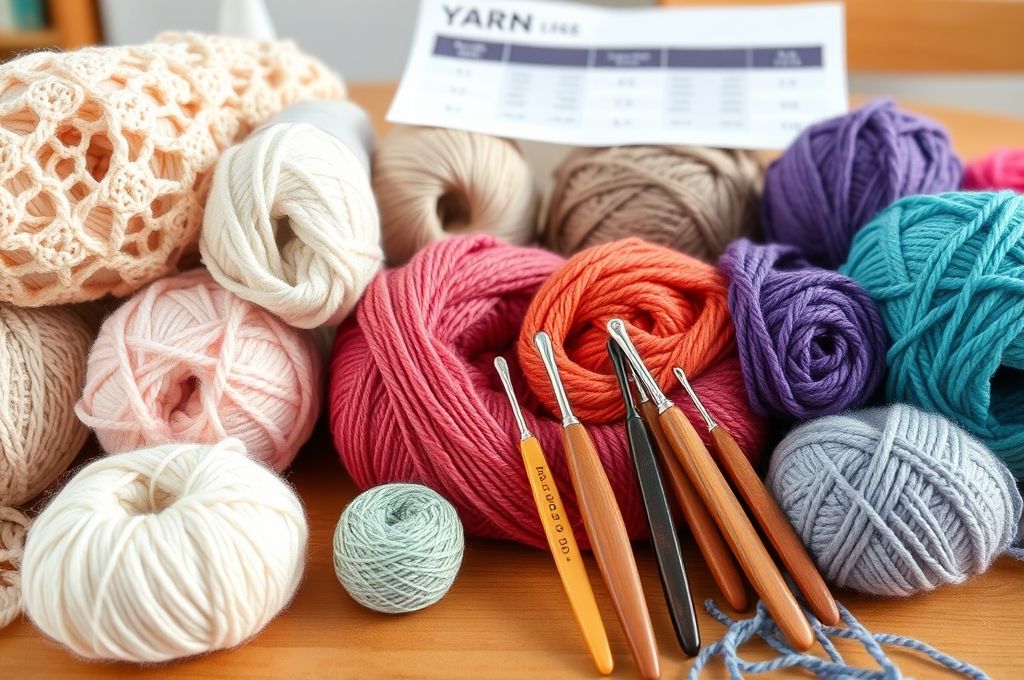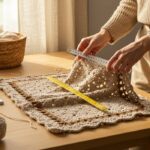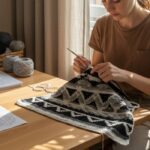Why Yarn Weight and Hook Size Matter
Have you ever started a crochet or knitting project with excitement, only to end up with a lopsided scarf, a hat that’s too tight, or a blanket that’s way bigger than expected? You’re not alone. The secret to consistent, beautiful results often lies in two simple—but often misunderstood—factors: yarn weight and hook (or needle) size.
These two elements work together like peanut butter and jelly—great on their own, but magical when paired correctly. Yet, many beginners overlook them, focusing only on patterns or colors, only to be disappointed later. Understanding how yarn thickness and tool size interact can transform your crafting experience from frustrating to fulfilling.
In this guide, we’ll break down everything you need to know about yarn weights and hook sizes in a clear, friendly way. Whether you’re just starting out or looking to refine your skills, you’ll learn how to choose the right materials for your projects, avoid common mistakes, and achieve professional-looking results—every time.
From decoding those confusing labels on yarn balls to mastering gauge swatches, we’ve got you covered. Let’s dive in and unravel the mystery behind the perfect stitch!
What Are Yarn Weights? (And Why They’re Not About Actual Weight)
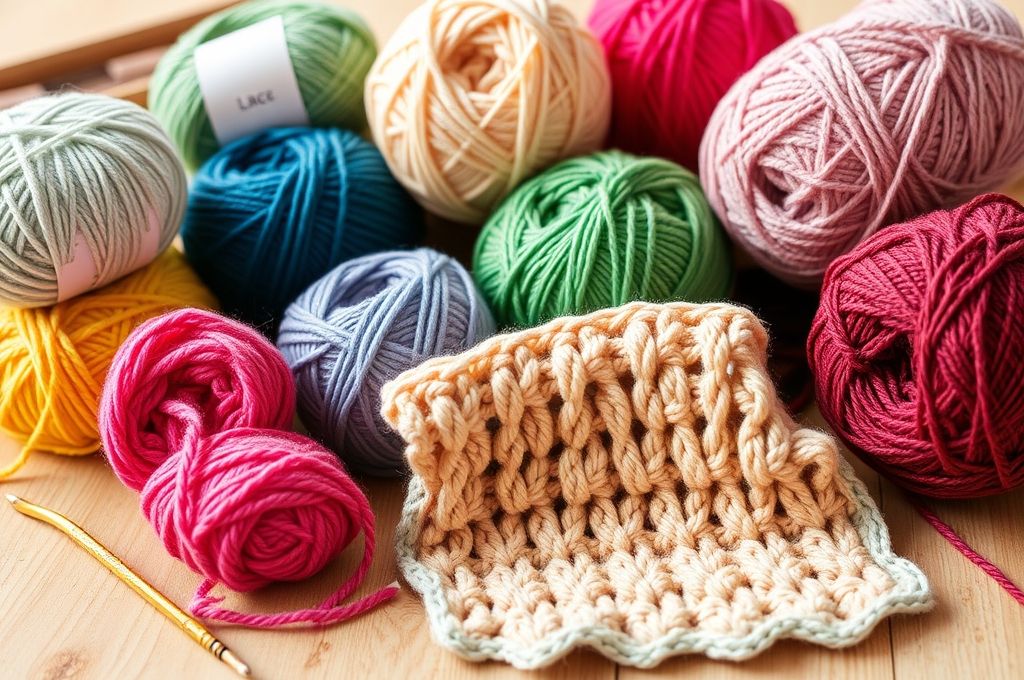
Let’s clear up a common misconception right away: yarn weight doesn’t refer to how heavy the yarn is. Instead, it describes the thickness of the yarn strand. Think of it like pasta—spaghetti, fettuccine, and angel hair are all pasta, but they vary in thickness and are used for different dishes. The same goes for yarn.
The Craft Yarn Council, the leading authority on yarn standards in the U.S., has established a standardized yarn weight system that ranges from 0 to 7. Here’s a quick overview:
- 0 – Lace: Extremely fine, delicate yarn used for shawls and doilies.
- 1 – Super Fine (Fingering): Great for socks, baby items, and detailed lacework.
- 2 – Fine (Sport): Slightly thicker than fingering, ideal for lightweight garments.
- 3 – Light (DK or Double Knitting): Versatile for sweaters, hats, and children’s clothes.
- 4 – Medium (Worsted/Aran): The most popular choice—perfect for beginners and everyday projects.
- 5 – Bulky (Chunky): Thick yarn for cozy blankets, scarves, and quick-knit items.
- 6 – Super Bulky: Extra-thick, used for ultra-warm winter wear.
- 7 – Jumbo: The thickest of all—great for arm knitting or giant statement pieces.
Choosing the right yarn weight isn’t just about aesthetics—it affects drape, warmth, stitch definition, and project time. A bulky yarn will knit up fast but may be too heavy for a delicate shawl. On the other hand, lace-weight yarn creates airy, elegant pieces but takes much longer to work with.
So, before you pick up any yarn, ask yourself: What kind of project am I making, and what kind of fabric do I want? That simple question can guide your choice and save you from frustration down the line.
Hook and Needle Sizes: The Tools That Shape Your Stitches
Now that you understand yarn weight, let’s talk about the tools: crochet hooks and knitting needles. Just like shoes come in different sizes, so do these crafting tools—and using the right size is crucial.
Hook and needle sizes are measured in millimeters (mm), but you’ll also see letter and number designations (like US H-8 or 5.0 mm). These sizes determine how large or small your stitches will be. Too small a hook with bulky yarn? Your hands will ache, and the fabric will be stiff. Too large a hook with fine yarn? Your stitches will be loose and uneven.
Here’s a general guideline for matching hook sizes to yarn weights:
| Lace (0) | 1.5–2.25 mm | 2.0–3.25 mm |
| Fingering (1) | 2.25–3.5 mm | 3.25–3.75 mm |
| Sport (2) | 3.5–4.5 mm | 3.75–4.5 mm |
| DK (3) | 4.5–5.5 mm | 4.5–5.5 mm |
| Worsted (4) | 5.5–6.5 mm | 5.5–6.5 mm |
| Bulky (5) | 6.5–9.0 mm | 6.5–9.0 mm |
| Super Bulky (6) | 9.0–12.75 mm | 9.0–12.75 mm |
| Jumbo (7) | 15 mm+ (or arm knitting) | 15 mm+ |
But here’s the catch: these are just starting points. Every yarn brand and fiber type behaves differently. Acrylic might behave differently than wool, even if they’re the same weight. That’s why patterns usually recommend a specific hook or needle size—and why it’s smart to check your gauge.
And don’t forget: hook material matters too. Aluminum hooks are smooth and fast, bamboo is warm and grippy, and plastic is lightweight and affordable. Choose what feels best in your hand!
The Magic of Gauge: Why Your Tension Affects Everything
You’ve picked the perfect yarn and the right hook size—so why does your project still not match the pattern? The answer might be in your gauge.
Gauge refers to the number of stitches and rows per inch in your knitting or crochet work. For example, a pattern might say: “Gauge: 16 stitches and 20 rows = 4 inches in single crochet.” If your swatch doesn’t match this, your finished piece will be too big or too small—even if you followed every step.
But here’s the truth: everyone crochets and knits differently. Some people work tightly, others loosely. This natural variation is called tension, and it’s completely normal. That’s why gauge swatches are your best friend.
How to Make a Gauge Swatch:
- Use the yarn and hook/needle recommended in the pattern.
- Crochet or knit a small square (about 6” x 6”).
- Measure how many stitches and rows fit into 4 inches.
- Compare it to the pattern’s gauge.
If your gauge is off, try adjusting your hook or needle size. Going up a size loosens your stitches; going down tightens them. It might feel like extra work, but it saves time and yarn in the long run.
Think of it like baking: would you make a cake without preheating the oven or measuring the flour? Probably not. The same care applies to crafting. Gauge ensures consistency, fit, and professionalism—especially for garments.
So, skip the swatch at your own risk. Your future self (and your beautifully fitting sweater) will thank you.
Common Mistakes and How to Avoid Them
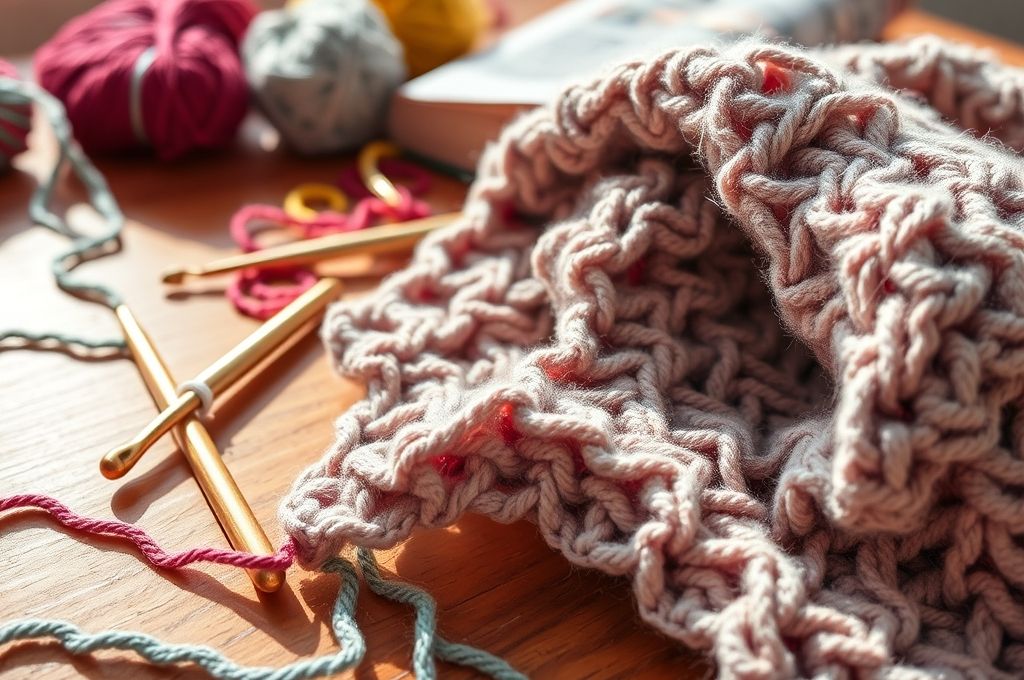
Even experienced crafters make mistakes when it comes to yarn weights and hook sizes. Here are some of the most common—and how to fix them:
1. Using the Wrong Yarn Weight Maybe you found a gorgeous pattern calling for worsted weight yarn, but you only have bulky on hand. “It’ll be fine,” you think. Spoiler: it won’t. Substituting a heavier yarn without adjusting the hook or pattern will result in a dense, oversized project.
✅ Solution: Stick to the recommended yarn weight, or if substituting, do a gauge swatch and adjust accordingly.
2. Ignoring the Hook Size on the Label Yarn labels list a recommended hook or needle size range. But just because it says “5.5–6.5 mm” doesn’t mean every project with that yarn should use a 6.0 mm hook.
✅ Solution: Use the label as a guide, but always follow the pattern’s recommendation and test your gauge.
3. Not Checking Gauge for Non-Flat Projects It’s easy to skip the swatch when making a scarf or dishcloth. But for hats, sweaters, or anything that needs to fit, gauge is non-negotiable.
✅ Solution: Always swatch for wearable items. Your time and materials are worth it.
4. Mixing Yarn Weights in One Project Using different weights unintentionally (like grabbing two skeins that look similar but aren’t the same) can create uneven texture and tension.
✅ Solution: Double-check labels and dye lots before starting. Keep packaging until the project is done.
5. Using the Wrong Hook Type A steel hook for lace vs. an aluminum hook for worsted—using the wrong tool can damage your yarn or strain your hands.
✅ Solution: Match hook material to yarn type. Steel for fine threads, aluminum or bamboo for medium to bulky.
Avoiding these pitfalls isn’t about perfection—it’s about being prepared. A little planning goes a long way.
Creative Freedom: When to Break the Rules
Now that we’ve covered the rules, let’s talk about breaking them—on purpose.
Once you understand the basics, you can start experimenting. Want a drapey shawl from a worsted-weight yarn? Use a larger hook to create looser, more flowing fabric. Want a denser, warmer blanket? Go down a hook size for tighter stitches.
This is where creativity shines. Changing hook size can completely transform a yarn’s personality.
For example:
- A DK yarn with a 4 mm hook creates a structured fabric.
- The same yarn with a 6 mm hook becomes airy and lacy.
- The same yarn with a 3 mm hook turns stiff and dense.
This technique is called creative tension, and it’s used by designers to achieve specific effects. You can use it too!
Another fun trick: mixing yarn weights intentionally. Stranded colorwork, tapestry crochet, or gradient projects often blend different weights for texture and visual interest. Just make sure they’re compatible—don’t pair lace with super bulky unless you’re going for a dramatic, sculptural look.
And don’t forget arm knitting! Using jumbo yarn or multiple strands held together lets you knit without needles, creating bold, modern pieces in hours.
So yes—learn the rules. But once you’ve mastered them, feel free to bend them. After all, crafting is an art, not a science.
How to Read Yarn Labels Like a Pro
Yarn labels are packed with useful information—if you know how to read them. Here’s what to look for:
1. Yarn Weight Symbol Look for the standardized number (0–7) and the symbol (a picture of a yarn ball with a number). This tells you the thickness at a glance.
2. Fiber Content Is it 100% acrylic? Merino wool? Cotton? Blends? Fiber affects softness, durability, and care. Wool stretches and breathes; acrylic is durable and easy to wash.
3. Yardage/Meters How much yarn is in the ball? This helps you calculate how many skeins you’ll need.
4. Care Instructions Can it go in the washer? Does it need hand-washing? Symbols show you how to care for your finished project.
5. Dye Lot Number This is critical! Yarn is dyed in batches, and slight color variations can occur between lots. Always buy enough yarn from the same dye lot to avoid visible color differences.
6. Recommended Hook/Needle Size As discussed, this is a starting point—not a rule carved in stone.
7. Gauge Information Often listed as “18 sc and 22 rows = 4 inches.” Use this for swatching.
Pro Tip: Take a photo of the label before you start your project. If you need more yarn later, you’ll have all the details handy.
Understanding labels empowers you to make informed choices—and avoid surprises mid-project.
Matching Yarn and Hook for Different Projects
Not all projects need the same yarn-hook combo. Here’s how to choose the best pairings based on what you’re making:
1. Baby Items (Blankets, Booties, Hats)
- Yarn: Light to medium weight (1–4), soft fibers like cotton or acrylic.
- Hook/Needle: 3.5–5.5 mm.
- Why: Softness and easy care are key. Avoid scratchy wools.
2. Winter Accessories (Scarves, Hats, Gloves)
- Yarn: Medium to bulky (4–5), warm fibers like wool or alpaca.
- Hook/Needle: 5.5–8.0 mm.
- Why: You want warmth and quick results. Bulky yarn works up fast.
3. Home Decor (Blankets, Pillows, Rugs)
- Yarn: Medium to super bulky (4–6), durable fibers.
- Hook/Needle: 6.0–10.0 mm.
- Why: Durability and visual impact matter. Thicker yarn creates bold texture.
4. Lace and Shawls
- Yarn: Lace to DK (0–3), often silk, bamboo, or fine wool.
- Hook/Needle: 2.0–5.0 mm.
- Why: You need fine tools to create delicate, openwork patterns.
5. Amigurumi (Stuffed Toys)
- Yarn: Light to medium (2–4), tightly spun yarn for stitch definition.
- Hook: 2.75–5.0 mm (smaller than usual).
- Why: Small hooks create tight stitches that won’t let stuffing show through.
6. Garments (Sweaters, Cardigans)
- Yarn: DK to worsted (3–4), with good drape.
- Hook/Needle: 4.5–6.5 mm.
- Why: Fit and comfort are essential—gauge is crucial here.
By aligning your materials with your project’s purpose, you set yourself up for success from the start.
Troubleshooting: What to Do When Things Go Wrong
Even with the right yarn and hook, problems can happen. Here’s how to fix common issues:
Problem: Stitches are too tight
- Cause: Hook too small or tension too firm.
- Fix: Try a larger hook or consciously relax your grip.
Problem: Fabric is too loose or holey
- Cause: Hook too big or yarn too slippery.
- Fix: Switch to a smaller hook or try a different yarn with more grip.
Problem: Project is curling at the edges
- Cause: Uneven tension or wrong stitch pattern for yarn weight.
- Fix: Add a border, block the piece, or adjust hook size.
Problem: Yarn splits easily
- Cause: Hook tip is too sharp or yarn is fragile.
- Fix: Use a blunt-tipped hook or switch to a smoother yarn.
Problem: Color fades after washing
- Cause: Poor dye quality or incorrect care.
- Fix: Always follow care labels and wash in cold water.
Problem: Hands hurt after crocheting
- Cause: Hook too small, too large, or poor ergonomics.
- Fix: Try ergonomic hooks, stretch your hands, or take breaks.
Remember: every mistake is a learning opportunity. Even pros encounter issues. The key is to stay patient and keep going.
Sustainability and Yarn Choices: Crafting with Care
As crafters, we also have the power to make eco-friendly choices. The yarn industry has a significant environmental impact, from water use in cotton farming to microplastics in synthetic fibers.
Here are ways to craft sustainably:
- Choose natural, biodegradable fibers like organic cotton, hemp, or undyed wool.
- Support ethical brands that pay fair wages and use low-impact dyes.
- Buy local or small-batch yarns to reduce carbon footprint.
- Reuse and repurpose old yarn from unwound projects.
- Recycle yarn labels and packaging.
Even small choices add up. Plus, sustainable yarns often feel better and last longer.
And here’s a fun idea: try upcycling. Turn old t-shirts into yarn (called “tarn”) for rug-making or tote bags. It’s zero-waste, free, and surprisingly strong!
Crafting isn’t just about making beautiful things—it’s about making thoughtful ones.
Conclusion: Mastering the Basics to Unlock Creativity
We’ve covered a lot—from understanding yarn weights and hook sizes to troubleshooting problems and making sustainable choices. But the big takeaway is this: the right materials make all the difference.
Yarn weight and hook size aren’t just technical details—they’re the foundation of every successful project. When you get them right, your stitches flow smoothly, your fabric drapes beautifully, and your finished piece looks exactly as intended.
But don’t let the rules intimidate you. Start with the basics, practice gauge swatches, and learn to read labels. Then, once you’re comfortable, experiment and make the craft your own.
Whether you’re knitting a cozy blanket for a loved one or crocheting a tiny amigurumi dragon, every stitch is a chance to create something meaningful.
So grab your favorite yarn, pick the right hook, and start crafting. And when you do, ask yourself: What will I make today?
We’d love to hear from you! What’s your go-to yarn weight? Have you ever had a project go wrong because of the wrong hook size? Share your story in the comments below—let’s learn and grow together.
Happy crafting! 🪡🧶

Daniele Ferreira is passionate about the world of crochet, dedicating her time to exploring techniques, creating unique pieces, and sharing her knowledge with beginners and aficionados alike. With attention to detail and creativity, she transforms yarn into true works of art, inspiring others to discover the beauty and joy of this manual art.

